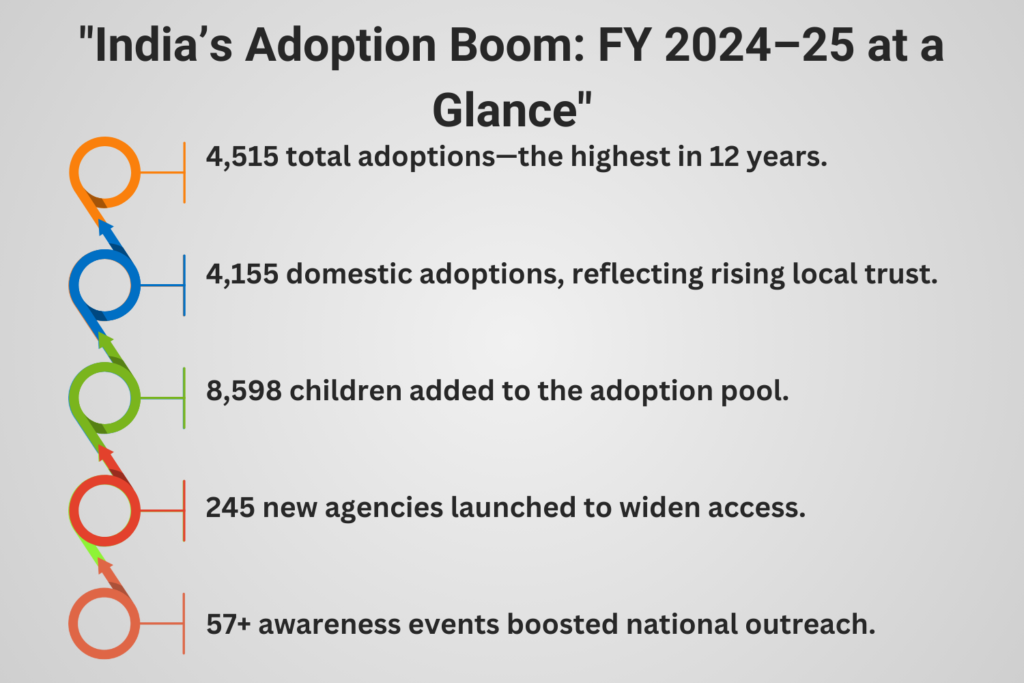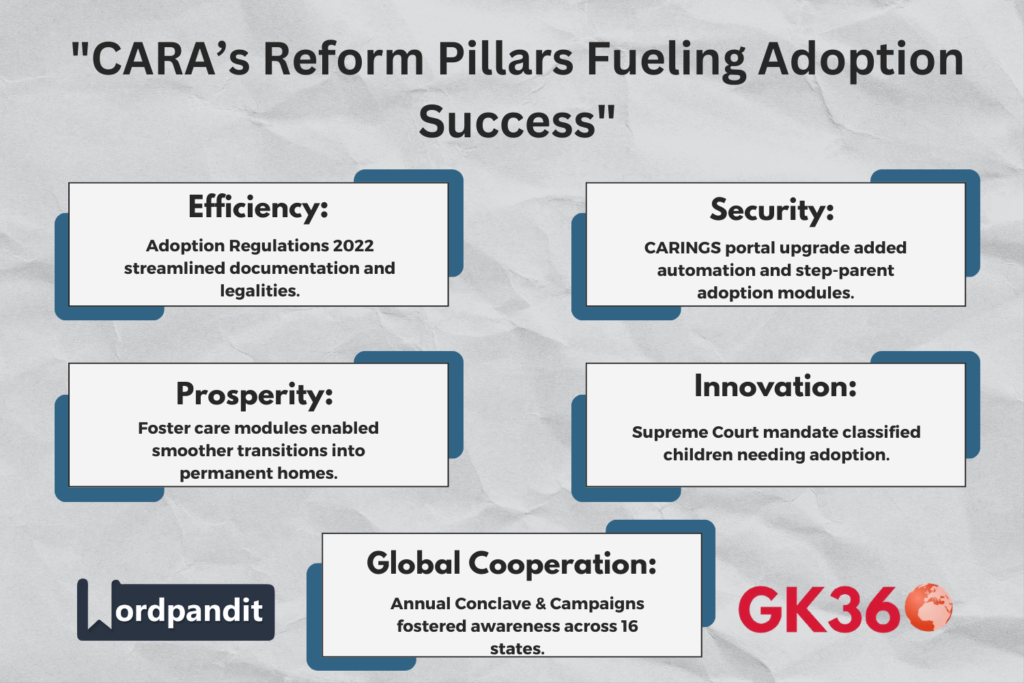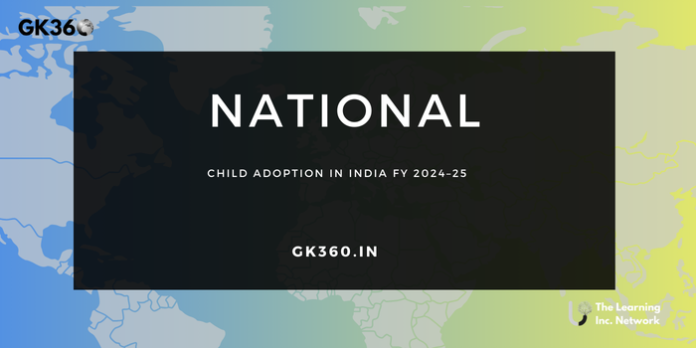Child Adoption in India FY 2024–25: CARA’s Reforms Drive Record Growth
India has recorded a heartwarming milestone in its child welfare journey—4,515 successful adoptions in FY 2024–25, the highest in over a decade. This remarkable achievement showcases how targeted reforms by CARA (Central Adoption Resource Authority) and the Ministry of Women and Child Development have made adoption more accessible, transparent, and widely accepted.
From streamlined digital platforms to nationwide awareness campaigns and legal interventions guided by the Supreme Court, India’s adoption ecosystem is evolving into a child-first, family-centric system. This year’s figures not only represent a number—they tell a story of hope, inclusion, and systemic transformation.

Table of Contents
- Record-Breaking Child Adoptions in FY 2024–25
- Key Reforms by CARA and Ministry of Women & Child Development
- Expanding the Adoption Pool and Setting Up New Agencies
- Digital Transformation via the CARINGS Portal
- Alternate Care Options: Foster Care & Adoption Modules
- Awareness and Training Campaigns Across India
- Supreme Court’s Directive: Identifying Children in Need
- FAQs About Child Adoption in India
- Conclusion: Building a Secure, Inclusive Future
Record-Breaking Child Adoptions in FY 2024–25
India registered 4,515 adoptions in FY 2024–25, the highest number in 12 years, marking a monumental leap in the nation’s adoption journey. Out of these, 4,155 were domestic adoptions, a sign of increasing public trust in the legal and institutional adoption framework.
These numbers signal a shift in societal perception—adoption is being embraced as a legitimate, loving way to build families, thanks to easier procedures, legal clarity, and robust monitoring systems.
Key Reforms by CARA and Ministry of Women & Child Development
Much of this success stems from targeted reforms initiated by CARA in collaboration with the Ministry of Women and Child Development:
- Streamlined regulations through the updated Adoption Regulations 2022, simplifying documentation and approvals.
- A shortened adoption timeline, now averaging just 3–4 months.
- Increased focus on non-institutional care like foster care and step-parent adoptions.
These reforms aim not only to boost adoption numbers but also to enhance the quality of care and legal protection provided to every child and family.
Expanding the Adoption Pool and Setting Up New Agencies
CARA prioritized increasing the availability of legally adoptable children while maintaining a strong focus on rights and child protection:
- 8,598 children were newly added to the adoption pool in FY 2024–25.
- 245 new Specialized Adoption Agencies (SAAs) were established across states and union territories, improving accessibility and outreach.
These agencies serve as ground-level bridges between abandoned or orphaned children and prospective adoptive parents (PAPs), ensuring every child is matched with a safe and nurturing family.
Digital Transformation via the CARINGS Portal
India’s adoption journey is now powered by technology, thanks to CARA’s upgraded CARINGS (Child Adoption Resource Information and Guidance System) portal. Key improvements include:
- Data cleansing and de-duplication, ensuring child records are accurate and up to date.
- New modules for relative and step-parent adoptions, making legal adoptions easier for blended and extended families.
- Automation of timelines to avoid delays and improve transparency.
This digital transformation has made the process more efficient, accountable, and family-friendly.
Alternate Care Options: Foster Care & Adoption Modules
Not all children are eligible or ready for adoption. Recognizing this, CARA introduced Family-Based Alternate Care (FBAC) options through:
- Foster Care Modules: Temporarily place children in nurturing homes while waiting for permanent solutions.
- Foster Adoption Modules: Allow foster parents to legally adopt when deemed fit.
These are integrated into the CARINGS portal and provide a more humane and personalized alternative to long-term institutional care, especially for older children or those with special needs.
Awareness and Training Campaigns Across India
To further destigmatize adoption and educate the public, CARA, in collaboration with state governments and child welfare bodies, launched a series of awareness initiatives aimed at building trust, clarity, and compassion.
Key Highlights:
- 12 physical orientation programs conducted across various states/UTs to educate local stakeholders.
- 45 virtual training sessions hosted for:
- Child Welfare Committees (CWCs)
- Adoption agencies
- Counselors
- Prospective Adoptive Parents (PAPs)
Nationwide Campaigns:
A standout effort was the Adoption Awareness Campaign (October 2024 – January 2025), covering 16 states. Activities included:
- Community events and experience-sharing sessions with adoptive families.
- The Annual Adoption Conclave in November 2024, attended by 500+ stakeholders, with special address by Minister of State Smt. Savitri Thakur, who emphasized expanding child advocacy and alternate care programs.
Supreme Court’s Directive: Identifying Children in Need
Following a directive from the Supreme Court of India, CARA initiated a nationwide classification exercise to identify and legally register children eligible for adoption.
Children were categorized as:
- Orphaned
- Abandoned
- Surrendered
- Children with No Visitation
- Children with Unfit Guardians
This legal framework ensures every child’s rights are protected and placement decisions are backed by accurate records, enhancing adoption transparency and child safety.
Challenges in the Adoption Ecosystem
While the record numbers are promising, India’s adoption ecosystem still faces several barriers:
- Underreporting of children in need due to lack of coordination across agencies.
- Lengthy court procedures in certain regions, despite CARA’s efforts to standardize.
- Stigma around adoption and reluctance to adopt older or disabled children.
- Lack of infrastructure and trained professionals in rural areas.
Addressing these challenges will require sustained investment, legislative consistency, and deeper community engagement.
Key Data Highlights
| Metric | FY 2024–25 Figures |
| Total Adoptions | 4,515 |
| Domestic Adoptions | 4,155 |
| Children Added to Adoption Pool | 8,598 |
| New Adoption Agencies Established | 245 |
| Awareness/Training Events Conducted | 57+ |
| Adoption Conclave Participation | 500+ stakeholders |

FAQs About Child Adoption in India
- What is CARA and what does it do?
CARA (Central Adoption Resource Authority) is the apex body under the Ministry of Women and Child Development that oversees adoption and alternate care processes in India. - How long does it take to adopt a child in India now?
Thanks to digital reforms, adoption timelines have been reduced to 3–4 months for most standard cases. - Can relatives or step-parents legally adopt children in India?
Yes. Recent updates to the CARINGS portal include modules for in-country relative adoptions and step-parent adoptions. - What is foster adoption?
Foster adoption allows families who have fostered a child to later adopt them permanently, based on eligibility and legal clearance. - How can I find legitimate adoption agencies in my state?
Visit the CARA website (cara.nic.in) and browse the list of Specialized Adoption Agencies (SAAs) by state/UT.
Conclusion: Building a Secure, Inclusive Future
India’s highest adoption figures in over a decade are not just statistical achievements—they are powerful symbols of transformation. They represent thousands of children who have found safe, loving, and permanent homes, and thousands of families who have opened their hearts and embraced adoption as a path to parenthood.
At the core of this change is a multi-layered reform ecosystem led by CARA, empowered by legal mandates from the Supreme Court, and supported by state-level child welfare bodies. Together, they have created an adoption environment that is faster, safer, and more compassionate than ever before.
The success of FY 2024–25 proves that when legal clarity, digital innovation, and social acceptance converge, the barriers to adoption begin to dissolve. India is moving steadily from institutional care models toward family-based systems, reflecting a global best practice that prioritizes emotional stability and holistic child development.
However, this momentum must not slow. There are still thousands of children—especially older ones, those with disabilities, and those in remote areas—waiting for the warmth of a home. There are still corners of society where adoption is misunderstood, and regions where awareness is lacking.
To truly ensure that no child is left behind, India must continue to:
- Invest in foster care, especially for children who may not be immediately adoptable.
- Integrate community counseling, post-adoption support, and monitoring mechanisms.
- Encourage single parents and non-traditional families to consider adoption.
- Break societal taboos and promote the idea that family is built on love—not just blood.
CARA’s progress in 2024–25 gives us hope—but also responsibility. A secure and inclusive future for India’s children lies not just in policy, but in our collective willingness to nurture, to accept, and to act
Key Takeaways Table
| Aspect | Details |
| Record Adoptions | 4,515 adoptions in FY 2024–25, a 12-year high |
| Digital Innovations | CARINGS portal enhanced for transparency, automation, and new adoption types |
| Legal & Policy Reforms | Simplified regulations and faster processing through Adoption Regulations 2022 |
| Expanded Adoption Pool | 8,598 children made available, 245 new agencies established |
| Supreme Court Intervention | Mandated identification and registration of adoptable children |
| Foster Care Integration | Family-Based Alternate Care (FBAC) modules launched for foster and blended care |
| Awareness Campaigns | 57+ events and a 16-state campaign promoted inclusivity and clarity |





